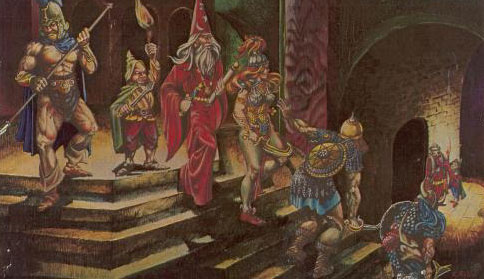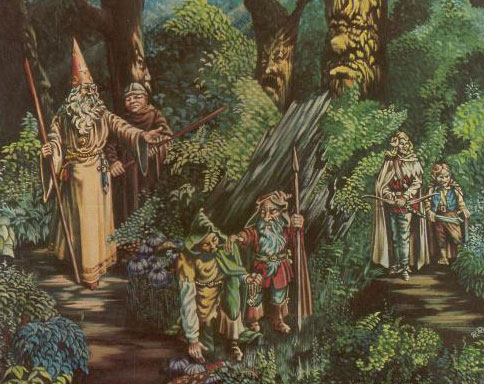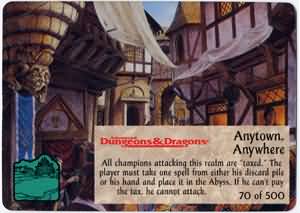THE ADVENTURE

THE ADVENTURE

|
|
|
|
|
When you go on an adventure,
you, and in all probability one or more other characters,
will go to explore some
underground
labyrinth || area of land outdoors.
Your DM will have carefully
prepared a map of the place you and your party are to enter,
a map showing all outstanding
features of the place,
with numbers and/or letters
to key encounter/special interest areas.
Your DM will give you certain
information prior to the adventure
-- you might have to ask
questions of the local populace,
or you might have heard
rumors or know of lejends --
so your party can properly
equip itself for the xpedition, hire men-atarms,
and obtain mounts or whatever
in order to have the best possible
chance for success in dungeon
|| wilderness setting.
Of course, going about a
city or town might in itself be interesting, informative, and dangerous,
so a third sort of adventure
can occur at any time, the city or town adventure.
These three major types
of adventures have elements in
common and differences;
so each will be described separately.
The various elements of
all sorts of adventures are given thereafter.
Your campaign referee has
detailed information, including charts, tables, and matrices,
so he or she will be completely
equipped for conducting any sort of adventure.
Preparation for one
of these adventures is ^highly^ important, and one can lead directly into
another sort altogether.
Here are the basic considerations
you will need to know to prepare your character for success.

Adventures into the underworld
mazes are the most popular.
The party equips itself
and then sets off to enter && explore the dungeons
of some castle, temple or whatever.
Light sources, poles for
probing, rope, spikes, and like equipment are the main
tools for such activity.
And, since none of the party
will know the dungeonís twists and turns, one or more of the adventurers
will have to keep a record,
a map, of where the party
has been. Thus you will be able to find your way out and return for yet
more adventuring.
As your party is exploring
and mapping, movement will be slow, and it is wise to have both front and
rear guards.
In the dungeon will be chambers
and rooms - some inhabited, some empty;
there will be traps to catch
those unaware, tricks to fool the unwise, monsters lurking to devour the
unwary.
The rewards, however, are
great -- gold, gems, and magic items.
Obtaining these will make
you better able to prepare for further expeditions,
more adept in your chosen
profession, more powerful in all respects.
All that is necessary is
to find your way in && out, to meet and defeat the guardians of
the treasures,
to carry out the wealth
...
Order of Play (OSRIC, page 138)
The order of events in a game TURN is as follows:
1. Wandering Monster Check:
Every 3rd turn the GM rolls
to see if any wandering
monsters are encountered (typically
1 in 6 -- consult specific
level key for non-standard
frequency of check or likelihood
of encounter).
2. Statement of Action:
Party caller or individual player describes
the activity of the various
party members, which
are resolved as appropriate
by the GM:
A.
MOVE:
Up to full move per turn for cautious movement
(incl.
mapping); 5x normal rate when passing
through
familiar areas
B.
Listen
for noise:
1 round per attempt, 10% standard
chance
for success (adjusted for class (thieves, assassins)
and race
(elves, gnomes, halflings, half-orcs), only
3 attempts
allowed per situation (e.g. door)
C.
Open
a stuck or locked door:
1 round per attempt, 2
in 6
standard chance for success (adjusted for STR)
for stuck
door, locked door requires key, knock spell,
exceptional
STR, lock picking, or breaking down
door,
unlimited retries allowed but no surprise possible
after
failed attempt.
D.
SEARCH for traps: 1-4 rounds per attempt (covering one
object
or location), chance of success determined by
race
(dwarf or gnome), class (thief or assassin) or
free-form
verbal negotiation (at GM's discretion)
E.
Casually examine (and map) a room or area: 1 turn
per 20
x 20 ft room or area
F.
Thoroughly examine and search for secret doors: 1
turn
per 10' x 10 ft area, 1 in 6 standard chance for success
(2 in
6 for elves and half-elves)
G.
CAST
a spell:
See specific spell descriptions in Chapter
II for
casting times and effects
H.
REST: Typically 1 turn in every 6, plus 1 turn after every
combat,
must be spent resting (i.e. no movement or any
other
strenuous activity)
I.
Other Activities: Duration of attempt and likelihood
of success
determined and resolved on ad-hoc basis
by GM
3. Encounters: If
an encounter (either with a wandering
monster or a planned encounter)
occurs, the GM determines
surprise, distance, reactions,
and resolves the encounter
normally (through negotiation,
evasion, or combat)
4. Book-keeping:
The records that a turn has elapsed
and deducts any resources
that the party has used (lost HP,
spell durations expiring,
torches burning out, and so on).
oldschooler wrote:
Quick, generic question:
When you do "dungeons" these days, do you still like the old-fashioned
12+ level megadungeons, or do you prefer smaller ones of, say, 1-3 levels?
I seem to notice most "in
print" dungeons getting much more shallow over the course of the past few
decades...

A module containing many
dungeon levels is perforce huge, a very lengthy and demanding project is
properly planned out.
The only time I have done
a mega-dundeon was for my gaming group.
Of course a version of that
work in now underway, and it includes the upper castle works as well as
many subterranean levels.
Smaller underground complexes are easily plugged into campaign play.
A massive one becomes the
heart of the campaign for a considerable
length of time.
When some of the regulars
want diversity, go off by themsleves on an outdoor
adventure,
the stay-at-home group will
be adventuring in the dungeons,
The time gap between the
two groups grows very lengthy, so it is necessary for the GM to either
play alternate groups--
with some device to have
the home-
based lot catch up in time
with the group on the journey,
or else have each group
create characters that join the other party,
thus effectively having
two separate and distinct adventuring parties run alternately,
unlikely ever to meet again...unless
the stay-at-home group leaves the dungeons in search of their wandering
fellows and finds them.
Whew!
Gary
Quote:
Originally Posted by blackshirt5
You're kinda vague there
Mr. Gygax. Tell us how you really feel. ![]()
What about the dungeon crawl
do you think makes it such a great medium for a game?
What is it about fighting
and thiefing(I know, not a real word, but one I picked up from my brief
stint in 2nd edition) your way through the ruins of a castle(or graveyard,
or evil temple) that appeals to you?

Appeals to me?
That sort of action-adventure
appeals to the vast majority of RPGers, as the success of new D&D amply
demonstrates.
Of far greater note is the
fact that the whole of the electronic RPG field is nothing but that sort
of play ![]()
The age group for the latter
sort of games is older than for the paper game too.
I'll not bother to go nto the psychological reasons for a coiuple of reasons--time and expertise <EEK!>
Cheers,
Gary
Quote:
Originally Posted by RFisher
Another couple of questions
have come to mind (and I guess it goes without saying to please forgive
me if they've been covered before):
Before I encountered D&D, the word "dungeon" meant to me merely an underground cell (or maybe a few cells). Was there precedent for using the word for a complex or were the dungeons under castles in the games merely turned into complexes for the sake of having someplace to explore?

Underground mazes have been
treated in mythology, fairy tales, and authored fiction (siuch as A
Journey to the Centre of the Earth ) long before this device was made
a central feature in the D&D game. (My favorite one from fairy tales
is the one about the 12 princessess who danced holes in their slippers
every night.) Anyway, the expanded underground
environment featuring dungeons was indeed meant for exploration, mapping,
and as a place for strange encounters.
Quote:
Originally Posted by Vlad
Le Démon
3. In D&D there is Dragons
and...Dungeons...why have you choose to set mostly of the adventures underground
?
This is not very flamboyant
and grandiose for great adventurers to crawl in the filth of tunnels and
catacombs ![]() .
.
There is a hidden meaning
for this ?

Heh, as if dungeon crawling
wasn't the most popular sort of adventure!
Note that mant action films
and most computer RPGs use such settings, whether actual dungeon-like places,
caves, or industrial-type enclosed environemnts.
think of the motion pictire
Alien.
The meaning is simple, to
bring fun and excitement to the players involved. What better than the
lurid tension of a subterranean maze?
![]()
Quote:
Originally Posted by Orius
...
Don't get me wrong, I like dungeons, and I like making them, but I think they just work better with low level PCs.

Or with high-level PCs whose
players are not power gamers seeking to become demi-gods or greater, rather
playing the game in the spirit in which it was meant![]()
Cheers,
Gary

I can say that detailed
world settings are not at all my cup of tea, for I believe that they constrain
the GM's innovation and creativity.
A detailed city is another
matter. That sort of information assists the GM in creating interesting
adventures.

Adventuring into unknown
lands or howling wilderness is extremely perilous at best,
for large bands of men,
and worse, might roam the AREA; there are dens of monsters, and trackless
wastes to contend with. Protracted expeditions are, therefore, normally
undertaken by higher level characters.
Forays of limited duration
are possible even for characters new to adventuring,
and your DM might suggest
that your party do some local exploration -- perhaps to find some ruins
which are the site of a dungeon or to find a friendly clan of dwarves,
etc. Mounts are necessary, of course, as well as supplies, missile weapons,
and the standard map-making
equipment. Travel will be at a slow rate in unknown areas, for your party
will be exploring, looking for foes to overcome, and searching for new
finds of lost temples, dungeons, and the like.
If the expedition continues
for several days, there will be a need to hunt for game to provide food,
unless some inhabited area is found -- a thorp, hamlet, village, or town
- in which case your party will then be able to have another short adventure.
Order of Play (OSRIC, page 142):
1. Setup: The GM advises
the party of prevailing weather
conditions and the party
decides which way to go.
2. Navigation: The
GM checks in secret to determine
if the party has become
lost.
3. Wandering
Monster Check:
The GM rolls for wandering
monsters.
4. Move and Act: Party
members move, make stationary
actions, or both.
5. Encounter: Any encounter is resolved.
6. Camp: The GM indicates
what options the party has
for a campsite. The party
camps.
7. Wandering Monster Check:
The GM rolls for
wandering monsters again,
and if one is met, begins
the resulting encounter.

Cities, towns, and sometimes
even large villages provide the setting for highly interesting, informative,
and often hazardous affairs and incidents.
Even becoming an active
character in a campaign typically requires interaction with the populace
of the habitation, locating quarters, buying supplies and equipment,
seeking information.
These same activities in
a completely strange town require forethought and skill.
Care must be taken in all
one says and does.
Questions about rank, profession,
god and alignment are perilous, and use of an alignment tongue is socially
repulsive in most places.
There are usually beggars,
bandits,
and drunks to be dealt with;
greedy and grasping merchants
and informants to do business with;
inquiring officials or suspicious
guards to be answered.
The taverns house many potential
helpful or useful characters, but they also contain clever and dangerous
adversaries.
Then there are the unlit
streets and alleys of the city after dark . . . And what lies in wait in
the deserted ruins of some lost ancient city?
Meat && drink for
the doughty
ADVANCED D&Der!

-

Quote:
Originally Posted by Melan
Greetings!
Gary, how do you feel about
city adventuring? Were cities a central feature in your campaigns, or were
they more like places to rest&shop between adventures?
Also, did you ever do a
writeup of Greyhawk City... And if yes, is there a chance to see it under
some other name - like "Dunfalcon City" or such?
About one adventure in 10
was run in a city--Greyhawk or some other. If the PCs were not seeking
adventure when there for R&R, bringing it to them was no problem ![]()

The original map of Greyhawk
city was one sheet of graph paper with colored boxes indicating various
places where PC would go--
inns & taverns, armorers,
money changers & banks, gemners & jewelers, city buildings, guilds,
etc.
That was expanded to two,
then four map sheets, with the thieves' quarter and Rob's Green Dragon
Inn shown.
I was working on a very
large version some 20 years back, but I abandoned it as far too detailed.
No version of the city that I designed has ever been published.
Cheers,
Gary
Quote:
Originally Posted by SuStel
Gary,
When you are preparing a town for your own refereeing (as opposed to preparing one for publication), how do you organize your notes? I've seen a number of techniques, including detailing individual buildings, detailing sections or neighborhoods of the town as if they were dungeon rooms, and just creating encounters to throw in as the referee decides.

A sketch map of the community,
a few places of interested highlighted in color, and then wing it.
As the PCs develop something
interesting by interacting with what I present that becomes a fixture in
the town.
This might be a particular
street thief, a tavern, a stable with a shifty
owner, whatever...
Cheerio,
Gary
Comments
Not sketchy at all. ;)
Some more xp...
